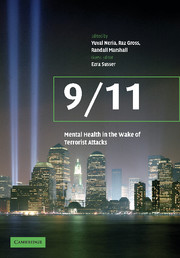Book contents
- Frontmatter
- Contents
- Acknowledgments
- Editors brief bio
- List of contributors
- Foreword
- Part I Introduction
- Part II The psychological aftermath of 9/11
- Part III Reducing the burden: community response and community recovery
- Part IV Outreach and intervention in the wake of terrorist attacks
- Part IV A New York area
- Part IV B Washington, DC
- Part IV C Prolonged-exposure treatment as a core resource for clinicians in the community: dissemination of trauma knowledge post-disaster
- Part V Disasters and mental health: perspectives on response and preparedness
- 29 The epidemiology of 9/11: technological advances and conceptual conundrums
- 30 Searching for points of convergence: a commentary on prior research on disasters and some community programs initiated in response to September 11, 2001
- 31 What mental health professionals should and should not do
- 32 Coping with the threat of terrorism
- 33 Life under the “new normal”: notes on the future of preparedness
- 34 Lessons learned from 9/11: the boundaries of a mental health approach to mass casualty events
- 35 Learning from 9/11: implications for disaster research and public health
- Index
34 - Lessons learned from 9/11: the boundaries of a mental health approach to mass casualty events
from Part V - Disasters and mental health: perspectives on response and preparedness
Published online by Cambridge University Press: 27 October 2009
- Frontmatter
- Contents
- Acknowledgments
- Editors brief bio
- List of contributors
- Foreword
- Part I Introduction
- Part II The psychological aftermath of 9/11
- Part III Reducing the burden: community response and community recovery
- Part IV Outreach and intervention in the wake of terrorist attacks
- Part IV A New York area
- Part IV B Washington, DC
- Part IV C Prolonged-exposure treatment as a core resource for clinicians in the community: dissemination of trauma knowledge post-disaster
- Part V Disasters and mental health: perspectives on response and preparedness
- 29 The epidemiology of 9/11: technological advances and conceptual conundrums
- 30 Searching for points of convergence: a commentary on prior research on disasters and some community programs initiated in response to September 11, 2001
- 31 What mental health professionals should and should not do
- 32 Coping with the threat of terrorism
- 33 Life under the “new normal”: notes on the future of preparedness
- 34 Lessons learned from 9/11: the boundaries of a mental health approach to mass casualty events
- 35 Learning from 9/11: implications for disaster research and public health
- Index
Summary
Introduction
For a foreigner who visits New York City, population heterogeneity is among the most striking features. There is also something futuristic about what one sees: A conglomerate of extreme opposites, somehow “functioning” together, bound by unannounced and apparently complex rules. Throwing a rock into such pond promises extreme reverberation, but also a somewhat better, though forced and transient, synchrony of waves and reactions.
For a time, following 9/11, one is told, hearts and minds in New York City became closer. Furthermore, since then “the City has changed,” acknowledge savvy New Yorkers, and cite as a proof the blackout night of August 14, 2003, in which people “were just out of themselves,” offering help and “acting like true community.” From anecdotes of ice-cream being given away by merchants on the streets, one can also appraise the extent to which charity, in New York, is typically combined with practicality. These will have melted anyhow, by the next morning.
Notwithstanding, in this book, the lessons of September 11, 2001, are mainly ones of “trauma,” “disaster” and “decline in mental health.” This is surprising, given the sense of common fate that should be hovering over the city since – or has it gone? Arguably, it is not the role of mental health specialists to identify resiliency – but rather to treat the diseased. To ignore it, however, is certainly not a good practice.
Additionally, this book highlights the presence of threat, fear, and post-traumatic symptoms, and one wonders what, indeed, was the relative part of loss, and by extension whether, beyond narrating the story of a “trauma,” mental health professionals actually have the vocabulary that properly expresses what has been, and is regularly being observed under duress.
- Type
- Chapter
- Information
- 9/11: Mental Health in the Wake of Terrorist Attacks , pp. 605 - 616Publisher: Cambridge University PressPrint publication year: 2006

